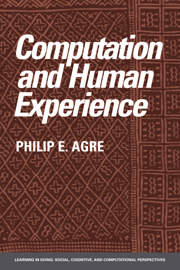Book contents
- Frontmatter
- Contents
- Preface
- 1 Introduction
- 2 Metaphor in practice
- 3 Machinery and dynamics
- 4 Abstraction and implementation
- 5 The digital abstraction
- 6 Dependency maintenance
- 7 Rule system
- 8 Planning and improvisation
- 9 Running arguments
- 10 Experiments with running arguments
- 11 Representation and indexicality
- 12 Deictic representation
- 13 Pengi
- 14 Conclusion
- Notes
- References
- Author index
- Subject index
3 - Machinery and dynamics
Published online by Cambridge University Press: 07 December 2009
- Frontmatter
- Contents
- Preface
- 1 Introduction
- 2 Metaphor in practice
- 3 Machinery and dynamics
- 4 Abstraction and implementation
- 5 The digital abstraction
- 6 Dependency maintenance
- 7 Rule system
- 8 Planning and improvisation
- 9 Running arguments
- 10 Experiments with running arguments
- 11 Representation and indexicality
- 12 Deictic representation
- 13 Pengi
- 14 Conclusion
- Notes
- References
- Author index
- Subject index
Summary
Mentalism
As a substantive matter, the discourse of cognitive science has a generative metaphor, according to which every human being has an abstract inner space called a “mind.” The metaphor system of “inside,” which Lakoff and Johnson (1980) call the CONTAINER metaphor, is extraordinarily rich. “Inside” is opposed to “outside,” usually in the form of the “outside world,” which sometimes includes the “body” and sometimes does not. This inner space has a boundary that is traversed by “stimuli” or “perception” (headed inward) and “responses” or “behavior” (headed outward). It also has “contents” – mental structures and processes – which differ in kind from the things in the outside world. Though presumably somehow realized in the physical tissue of the brain, these contents are abstract in nature. They stand in a definite but uncomfortable relation to human experiences of sensation, conception, recognition, intention, and desire. This complex of metaphors is historically continuous with the most ancient Western conceptions of the soul (Dodds 1951; Onians 1954) and the philosophy of the early Christian Platonists. It gradually became a secular idea in the development of mechanistic philosophy among the followers of Descartes. In its most recent formulation, the mind figures in a particular technical discourse, the outlines of which I indicated in Chapter 1.
This metaphor system of inside and outside organizes a special understanding of human existence that I will refer to as mentalism. I am using the term “mentalism” in an unusually general way. The psychological movements of behaviorism and cognitivism, despite their mutual antagonism, both subscribe to the philosophy of mentalism.
- Type
- Chapter
- Information
- Computation and Human Experience , pp. 49 - 65Publisher: Cambridge University PressPrint publication year: 1997



